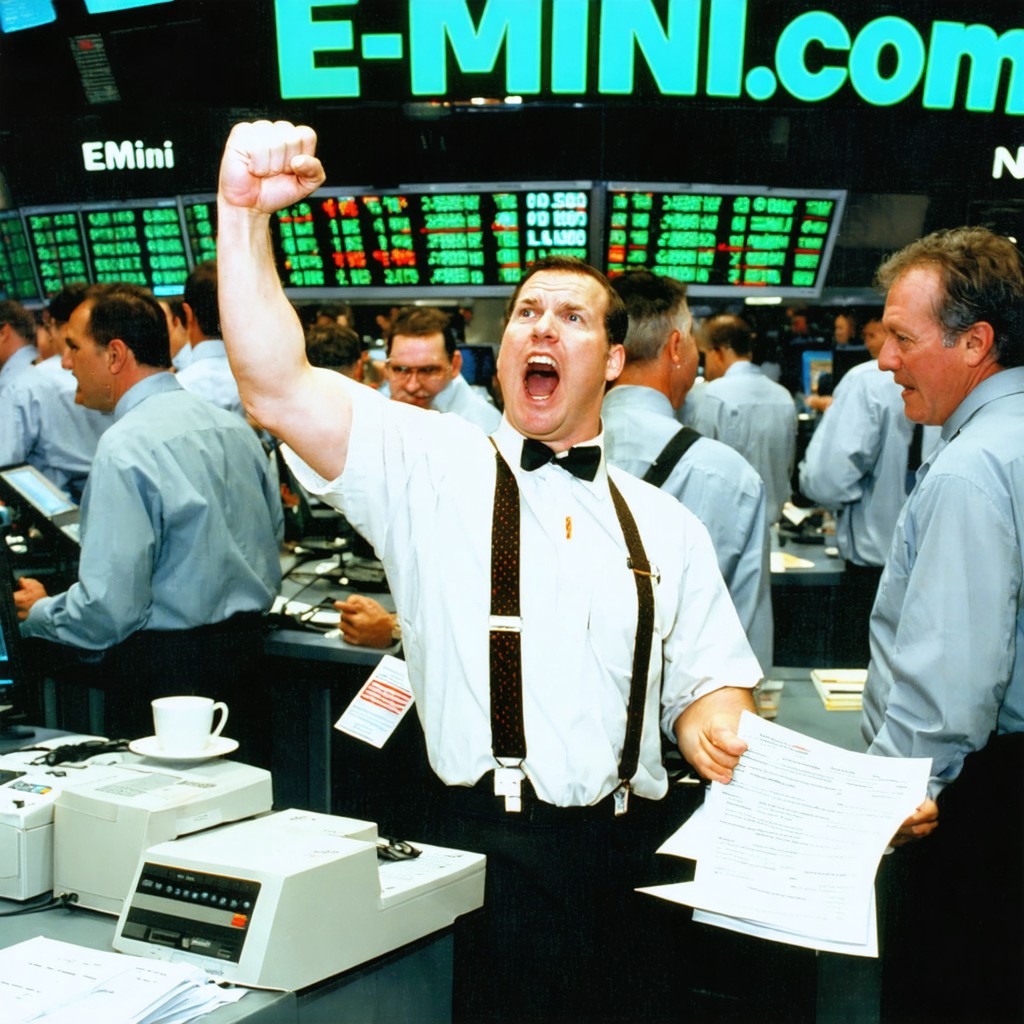E-mini Nasdaq futures, commonly referred to as e-mini contracts, are a subset of financial instruments that allow traders to speculate on or hedge against movements in the Nasdaq-100 Index. The Nasdaq-100 represents the largest non-financial companies listed on the Nasdaq exchange, featuring giants like Apple, Microsoft, and Amazon. E-mini Nasdaq futures are particularly attractive for futures trading due to their smaller contract sizes, lower margin requirements, and accessibility to both retail and institutional traders.
These contracts were introduced in 1999 by the Chicago Mercantile Exchange (CME) in response to the rising demand for more accessible futures contracts, especially from retail traders. Today, e-minis are among the most popular contracts globally, especially for traders who prefer futures trading on stock indices.
Why Are E-Mini Contracts So Popular?
E-mini contracts, including e-mini Nasdaq futures, have gained immense popularity in futures trading for several reasons. First, their contract size makes them accessible to a broader range of traders, from individual retail investors to large institutions. Compared to traditional futures, which often have high notional values, e-mini contracts provide a more affordable way to trade indices like the Nasdaq-100.
Another factor contributing to their popularity is liquidity. The Nasdaq futures market, particularly e-mini Nasdaq futures, offers high liquidity, enabling traders to enter and exit positions swiftly without impacting the market price significantly. This high liquidity also means narrower bid-ask spreads, reducing the cost of trading futures. The availability of e-minis extends beyond regular market hours, allowing for 24-hour trading, which is advantageous for those who want to capitalize on global market movements, such as Asian and European market open times.
Moreover, e-mini contracts are also leveraged products, meaning that traders only need to deposit a fraction of the total contract value as margin. This allows for the potential of high returns but also comes with increased risk, making risk management crucial in trading futures like emini Nasdaq futures.
How E-Mini Nasdaq Futures Complement Stock Index Trading
E-mini Nasdaq futures are closely tied to the Nasdaq-100 Index, making them a convenient way to trade on this prominent stock index without owning individual stocks. For those involved in stock index trading, emini Nasdaq futures provide a way to gain broad exposure to the Nasdaq-100, enabling traders to capitalize on movements in the tech-heavy index.
These futures also allow for a hedging mechanism that complements stock index trading. For example, a trader who holds a portfolio of tech stocks can use emini Nasdaq futures to hedge against potential downside risks in the Nasdaq-100 Index. If the index declines, the loss in the portfolio might be offset by gains in the short futures position. Thus, e-minis serve as both a speculative instrument for those betting on market movements and a hedge for portfolio managers seeking to reduce exposure to certain market risks.
Advantages of Trading E-Mini Nasdaq Futures
Leverage and Capital Efficiency
One of the key advantages of trading e-mini Nasdaq futures is leverage. Futures traders only need to post a margin, which is typically a small percentage of the contract’s value, allowing them to control a larger position with a smaller upfront investment. This is attractive to retail traders with limited capital, as well as institutional traders who want efficient capital allocation.
Accessibility and Liquidity
E-mini Nasdaq futures have some of the highest liquidity among futures contracts, ensuring tight bid-ask spreads and making it easy to execute large trades without significantly affecting market prices. This high liquidity benefits retail traders by lowering transaction costs and ensuring fast execution, while institutional traders can enter or exit large positions swiftly.
24-Hour Market Access
The extended trading hours of e-mini Nasdaq futures offer an advantage for those who want to trade on news or events occurring outside of regular trading hours. This feature allows traders to respond immediately to global developments, whether they are based in Asia, Europe, or the Americas.
Hedge Against Market Volatility
For hedgers, e-mini Nasdaq futures offer a way to protect against potential market volatility. Hedgers, including portfolio managers, can use these futures to mitigate losses in a declining market or lock in gains by taking opposite positions.
Cost-Effective and Efficient
Compared to traditional Nasdaq futures, e-minis offer lower initial margin requirements, making them more accessible to smaller investors. This feature is particularly advantageous for individual traders and small firms, allowing them to participate in futures trading on major stock indices with limited resources.
Disadvantages of Trading E-Mini Nasdaq Futures
High Volatility and Leverage Risk
The leverage associated with e-mini Nasdaq futures is a double-edged sword. While it enables higher returns, it also increases potential losses. High volatility in the Nasdaq-100 Index, especially during periods of market turbulence, can lead to substantial gains or losses in a short time, making it essential for retail traders to have effective risk management strategies.
Complexity of Futures Contracts
For retail traders, the complexity of futures trading can be a disadvantage. Understanding margin requirements, settlement procedures, and the impact of leverage requires knowledge and experience. Unlike stock trading, futures trading involves specific terms and conditions that can be challenging for beginners.
Potential for Large Losses
Leverage in futures trading means that even a small adverse move in the market can lead to significant losses. Institutional traders and hedgers might have strategies to mitigate these risks, but individual traders with smaller portfolios can quickly find themselves overextended if the market moves against their positions.
E-Mini Nasdaq Futures for Different Types of Traders
For Retail Traders
Retail traders are drawn to e-mini Nasdaq futures due to their affordability, high liquidity, and the ability to capitalize on movements in the Nasdaq-100 without needing to invest in individual tech stocks. However, retail traders must manage their positions carefully, as leverage can magnify both gains and losses. Using stop-loss orders and understanding margin requirements are crucial strategies for retail traders to avoid large losses in this volatile market.
For Institutional Traders
Institutional traders often use e-mini Nasdaq futures to gain exposure to the tech sector quickly and efficiently. They value the liquidity of these contracts, which allows them to take substantial positions without moving the market. Institutional traders might use sophisticated quantitative models and algorithmic strategies to optimize returns in e-mini Nasdaq futures, making these contracts an essential tool in their trading arsenal.
For Hedgers
Hedgers, such as portfolio managers with significant exposure to tech stocks, can use e-mini Nasdaq futures to protect against market downturns. By shorting e-mini Nasdaq futures, hedgers can offset losses in their portfolios if the Nasdaq-100 declines. This approach is particularly valuable in uncertain economic conditions, where maintaining a balanced exposure becomes a priority.
Hedging Strategies with E-Mini Nasdaq Futures
Hedging is a key component of risk management in futures trading. E-mini Nasdaq futures offer several strategies for effective hedging against fluctuations in the Nasdaq-100 Index.
Direct Short Hedge
A direct short hedge involves shorting e-mini Nasdaq futures to protect a portfolio of Nasdaq stocks against downside risk. This strategy is beneficial for investors holding tech stocks who want to protect their portfolio in case the index declines. The short position in e-mini Nasdaq futures would generate gains if the index drops, offsetting losses in the underlying stocks.
Ratio Hedging
With ratio hedging, a trader calculates the beta of their portfolio to the Nasdaq-100 Index and then uses that ratio to determine the appropriate number of e-mini Nasdaq futures contracts to hedge. For instance, if a portfolio has a beta of 1.2, a trader might hedge by taking a position that covers 1.2 times the exposure, offering more tailored protection against market volatility.
Cross-Hedging with Other Indices
Cross-hedging involves taking positions in e-mini Nasdaq futures while holding stocks in a similar but not identical index. This approach allows traders to benefit from correlations between indices. For example, an investor holding a portfolio of tech-heavy assets might use e-mini Nasdaq futures as a hedge against declines in their holdings, even if they are not strictly part of the Nasdaq-100.
Dynamic Hedging
Dynamic hedging requires adjusting the hedge ratio as market conditions change. If volatility rises, a trader might increase their short position in e-mini Nasdaq futures to account for increased risk. Conversely, if volatility decreases, they might reduce the hedge, thus keeping the hedge cost-effective while maintaining adequate protection.
E-mini Nasdaq futures offer a compelling combination of accessibility, liquidity, and leverage, making them a popular choice in futures trading for both retail and institutional traders. For retail traders, e-mini Nasdaq futures provide an affordable way to gain exposure to the Nasdaq-100, though the leverage and complexity of futures trading necessitate careful risk management. Institutional traders and hedgers value e-mini Nasdaq futures for their liquidity and effectiveness as a hedge against Nasdaq-100 fluctuations.
Despite the risks associated with high leverage, e-mini Nasdaq futures remain a favored instrument for speculative trading, long-term investments, and hedging. They serve as an effective complement to traditional stock index trading, providing a streamlined, cost-effective alternative to buying or selling large amounts of Nasdaq stocks. With strategic use and robust risk management, e-mini Nasdaq futures continue to be a versatile tool in the world of futures trading, offering opportunities to profit and protect against market volatility for diverse trading needs.
To open a futures account with E-Mini.com, please click here.
Ready to start trading futures? Call US 1(800)454-9572 – Int’l (310)859-9572 email info@cannontrading.com and speak to one of our experienced, Series-3 licensed futures brokers and start your futures trading journey with E-Mini.com today.
Disclaimer – Trading Futures, Options on Futures, and retail off-exchange foreign currency transactions involves substantial risk of loss and is not suitable for all investors. Past performance is not indicative of future results. You should carefully consider whether trading is suitable for you in light of your circumstances, knowledge, and financial resources. You may lose all or more of your initial investment. Opinions, market data, and recommendations are subject to change at any time.
Important: Trading commodity futures and options involves a substantial risk of loss. The recommendations contained in this writing are of opinion only and do not guarantee any profits. This writing is for educational purposes. Past performances are not necessarily indicative of future results.
**This article has been generated with the help of AI Technology. It has been modified from the original draft for accuracy and compliance.
***@cannontrading on all socials.







